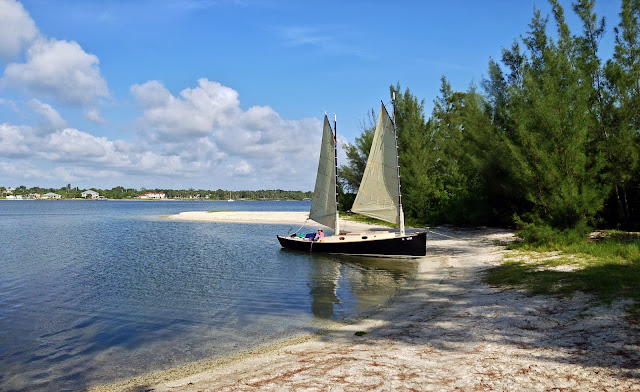We launched Friday afternoon at Honest John's Fish Camp. Honest John's is a wonderful place on the Indian River Lagoon. Established in 1880 it is still owned by the same family and has a laid back old Florida charm that is becoming hard to find. Since Commodore Munroe built the original Egret in 1886 there's a good chance that he visited Honest John's at some point.
It's a short and very shallow sail from Honest John's to our favorite island, IRL1. We could see bottom most of the time with depths ranging from 2-3ft with deeper channels. As usual on Egret we ignored all navigation aids and just sailed where we pleased. The cove on IRL1 was pretty full of WCTSS boats as we arrived late Friday afternoon.
Folks were chatting and hiding from the sun.
Fleet on the beach. Yes that's a pirate ship at anchor in the cove. No one was home.
Ron Hoddinott admiring Friday's sunset.
Fred and Ted's excellent adventure. We sailed the Egret for a couple of hours Saturday afternoon. The weather was perfect. Note how much helm Fred is having to hold to keep the boat on course.
The water in Indian River Lagoon, near Sebastian inlet, was spectacularly clear.
I wanted to introduce Egret to the Atlantic and the crew was game so we poked out Sebastian inlet for a while.
Pointing and reaching Egret handled the 4ft waves nicely. She tracked well and had a pleasant motion. It was a dead down wind run coming back into the inlet and the waves were piling up a bit against the outgoing tide so the ride got a little uncomfortable. Egret is not fast enough to surf in those conditions and she rolled pretty severely with each passing swell. Not sure what is going on there as the Commodore specifically mentions Egret's ability to run off the wind with full sails up in almost any weather. Either we don't know how to sail the boat (very possible) or the Commodore's idea of a good ride is more than I'm willing to put up with.
Sailing in waves is fun.
Our GPS track from IRL1 out Sebastian inlet. We were not working real hard at sailing the boat, just casually tacking upwind. On one tack we paid attention to the compass and it looked like we were tacking through 100-110 degrees. The track tells the whole story. The best of the tacks is 128 degrees and the worst 146. Average is in the high 130 degree range. Basically same as before the bilge board repairs. Both boards were down. So the boat is still making a ton of leeway. Oh, and we had an outgoing tide helping us along.
Coming back down the channel from Sebastian inlet. Lots of powerboat traffic. Picture by Dennis Marshall.
Picture by Dennis Marshall.
Picture by Dennis Marshall.
Picture by Dennis Marshall.
Saturday night campfire.
Everyone bugged out early on Sunday so we had the cove to ourselves for a little while.
Us and the Evinrude powered pirates.
On the way back to Honest John's.
We anchored near the ramp at Honest John's and dropped the masts. Much nicer out in the breeze then roasting in a parking lot. Stopped for lunch on the way out at the Sebastian Beach Inn. This is the beach in front of the restaurant. There are quite a few houses along A1A where the owners have to stare at this sort of thing on a daily basis.
More pics from the trip at the West Coast Trailer Sailor's website.




























































